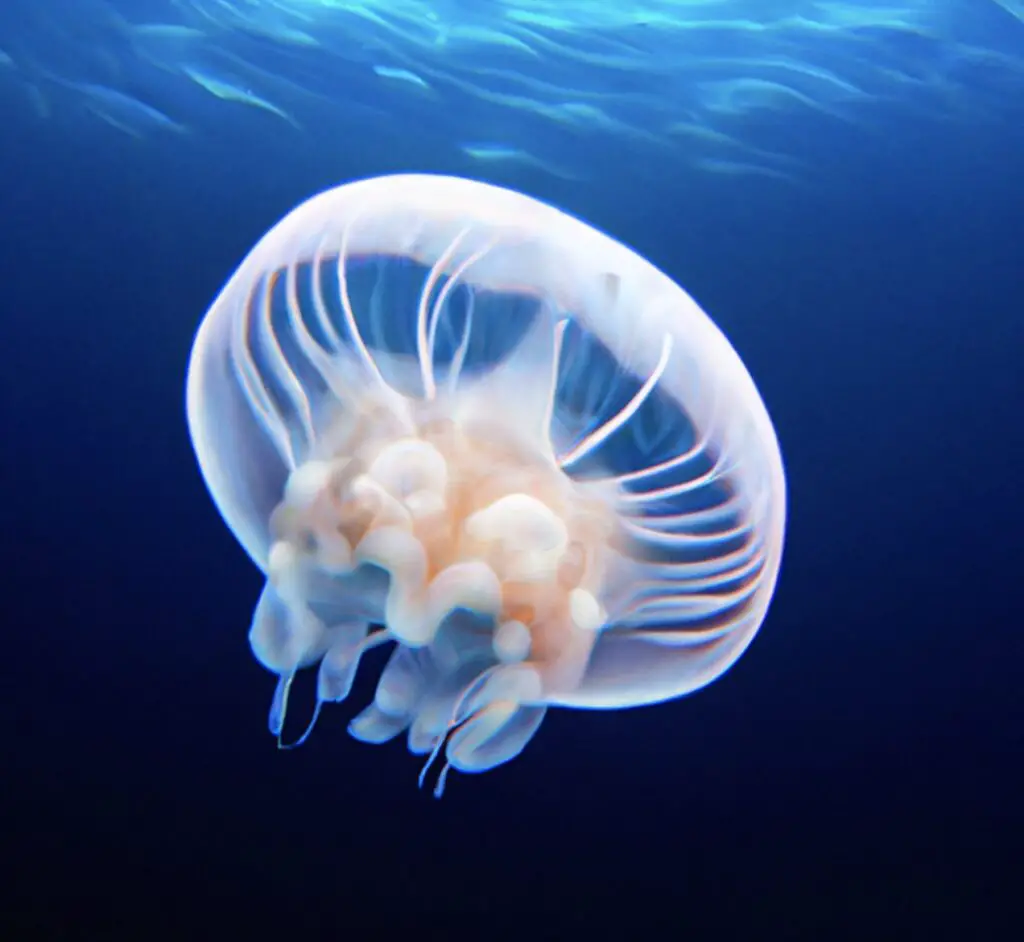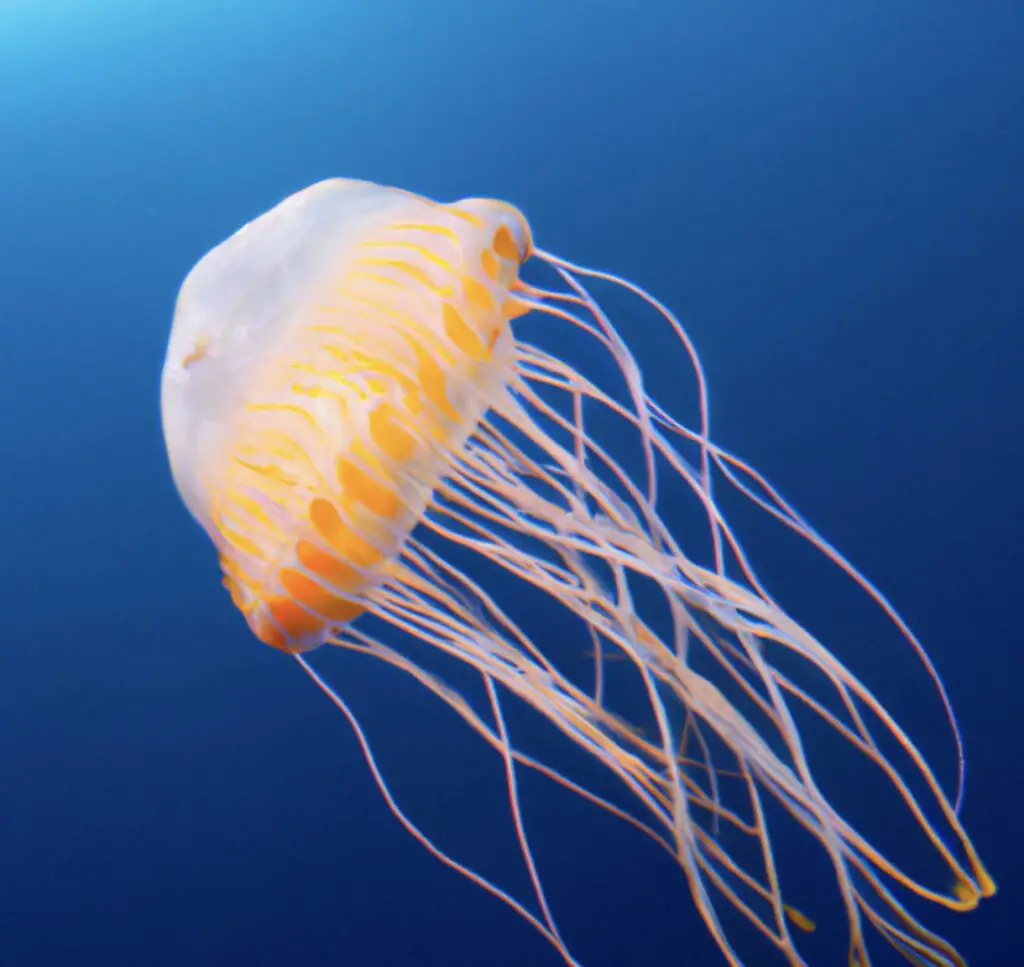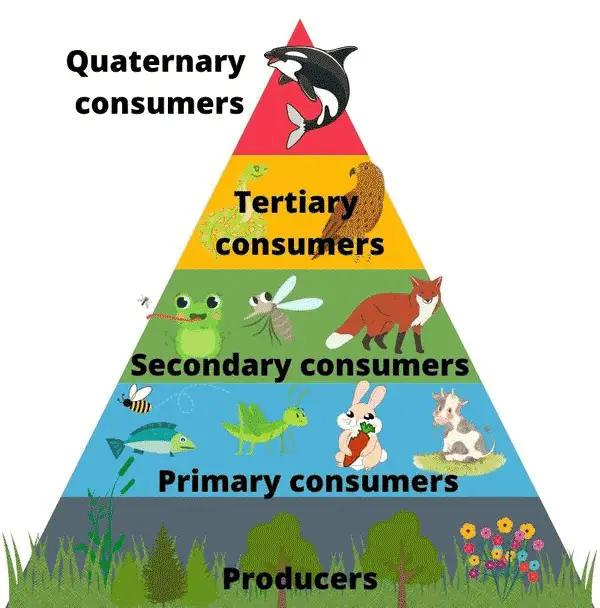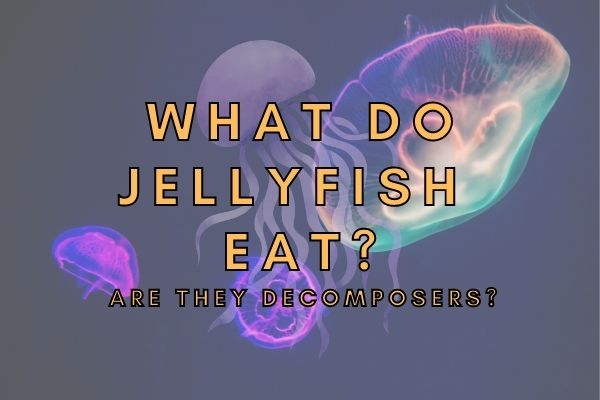Jellyfish are carnivorous marine animals that feed on planktonic organisms, small crustaceans, fish eggs, larvae, and small fish.
They use their tentacles to sting and paralyze their prey before eating them. Jellyfish are found in all the world’s oceans, from the surface to the deep sea. Some species of jellyfish can grow to be over two meters in diameter!
Jellyfish are often considered opportunistic carnivores, meaning they primarily feed on small aquatic organisms such as plankton, fish eggs, larvae, and small crustaceans. Some larger jellyfish species may also prey on smaller jellyfish.
Jellyfish are secondary consumers as they eat other animals that mostly feed on plants in the ocean but larger jellyfish may be considered tertiary consumers as well.
Jellyfish are not decomposers as they do not eat decaying matter but living organisms like plankton, shrimp and fish.
Jellyfish are beautiful creatures with a fascinating life cycle. They start out as tiny polyps attached to rocks or coral reef.
The polyps reproduce asexually and release medusa, which are free-swimming jellyfish. After reproducing sexually, the medusa die and the cycle starts over again!
Are Jellyfish Carnivores, Herbivores or Omnivores?
Generally, jellyfish are carnivores and eat other animals. However, jellyfish larvae (baby jellyfish) consume more plant material with mostly planktonic organisms (tiny sea creatures like algae) that float or swim in water. As an adult, jellyfish will eat larger animals like crustaceans or larvae of fish.
Jellyfish live in oceans around the world. They mostly live in shallow waters near shore. In some areas, jellyfish are common. In other areas, they cannot be found. Jellyfish are thought to float to shore near shore and move to deeper waters for breeding.
When it comes to their dietary preferences, jellyfish are typically classified as carnivores, but their feeding habits can vary depending on the species and the availability of food sources in their environment.
Firstly, it’s important to understand that jellyfish lack specialized digestive systems like those found in many other animals.

They have a simple body structure consisting of a bell-shaped body called the medusa, which is surrounded by tentacles. These tentacles contain specialized cells called cnidocytes, which are armed with tiny harpoon-like structures known as nematocysts. These nematocysts are used by jellyfish for both defense and capturing prey.
As carnivores, jellyfish primarily feed on small planktonic organisms. This includes various types of zooplankton, such as tiny crustaceans, larval fish, and other small invertebrates. The tentacles of jellyfish are equipped with stinging cells that help immobilize their prey.
When a potential meal comes into contact with the tentacles, the nematocysts fire, injecting venom into the prey and immobilizing it. The tentacles then bring the captured prey towards the jellyfish’s mouth, located on the underside of its bell-shaped body. The prey is ingested into the gastrovascular cavity, where it is partially digested.
While jellyfish are primarily carnivorous, there are instances where they exhibit opportunistic feeding behaviors, making them somewhat omnivorous.
Some jellyfish species have been observed consuming plant material, such as algae and other microscopic organisms, when the availability of prey is limited. However, these instances are relatively rare, and the bulk of their diet consists of animal matter.
It’s worth noting that not all jellyfish species have the same dietary preferences. Some species, like the moon jellyfish (Aurelia aurita), have a more varied diet and are known to consume a wider range of prey, including other jellyfish.
On the other hand, certain deep-sea species have adapted to survive in environments with scarce food resources and have developed specialized feeding mechanisms.
These species rely on capturing and consuming small particles of organic matter that sink down from surface waters, a feeding strategy known as “marine snow” feeding.
In summary, while jellyfish are commonly classified as carnivores due to their primary diet consisting of small planktonic organisms, they can display some degree of omnivory, particularly in situations where prey is limited.
However, it’s important to recognize that jellyfish exhibit a diverse range of feeding strategies and their dietary preferences can vary between species and in response to environmental conditions.
Primary Diet of the Jellyfish
The diet of jellyfish is primarily composed of small aquatic organisms, including plankton, fish eggs, larvae, and other invertebrates. However, it is important to note that the diet of jellyfish can vary depending on the species and their habitat.
Jellyfish eat zooplankton, small fish, fish eggs, other jellyfish and larvae. They mostly eat single-celled organisms (zooplankton) that float around in the ocean.
Jellyfish are classified as carnivorous predators, although their feeding habits are quite different from those of most animals. Unlike active hunters, jellyfish are passive feeders that rely on their unique anatomy and feeding mechanisms to capture and consume their prey.

The primary feeding apparatus of a jellyfish is its tentacles. These tentacles are equipped with specialized cells called cnidocytes, which contain tiny harpoon-like structures known as nematocysts.
When a jellyfish comes into contact with its prey, these nematocysts are triggered, launching harpoons that inject venom into the prey organism. This venom serves to immobilize or kill the prey, making it easier for the jellyfish to consume it.
Once the prey is immobilized, the jellyfish uses its tentacles to bring it towards its mouth, which is located on the underside of its bell-shaped body. The mouth leads to a gastrovascular cavity, which acts as both the digestive and circulatory system of the jellyfish. The cavity is lined with cells that secrete digestive enzymes to break down the prey into smaller, more manageable pieces.
While jellyfish can consume a variety of prey, their diet is largely determined by what is available in their surrounding environment. Some jellyfish species primarily feed on zooplankton, which includes tiny crustaceans and other small invertebrates drifting in the water. They use their tentacles to create a network of mucus that captures these microscopic organisms as they pass by.
Other jellyfish species are opportunistic feeders and will consume whatever prey is abundant in their habitat. This can include fish eggs, fish larvae, small fish, and even other jellyfish. Some larger species of jellyfish have been known to eat small crustaceans, mollusks, and even small sea birds.

It’s worth noting that jellyfish are not particularly efficient predators. Their gelatinous bodies offer little resistance to the water, making it difficult for them to move quickly or chase after prey. Instead, they rely on drifting with ocean currents and tides, waiting for prey to come into contact with their tentacles.
Jellyfish populations can undergo dramatic fluctuations in response to changes in environmental conditions, such as temperature, salinity, and nutrient availability. Blooms of jellyfish, where large numbers of individuals congregate in a particular area, can occur when conditions are favorable for their survival and reproduction. During these blooms, jellyfish can have a significant impact on local ecosystems, as their feeding can affect the abundance and distribution of other organisms in the food web.
In summary, the diet of jellyfish consists primarily of small aquatic organisms, including plankton, fish eggs, larvae, and other invertebrates. Their passive feeding strategy, relying on tentacles and venomous stinging cells, allows them to capture and consume their prey. However, the specific diet of jellyfish can vary depending on the species and environmental conditions, with some being specialized feeders while others are more opportunistic in their feeding habits.
Is a Jellyfish a Producer, Consumer or Decomposer?
Jellyfish are consumers because they must eat other organisms for their energy and carbon source. They are secondary consumers because they eat other animals.
When considering their ecological role and the flow of energy in ecosystems, it is important to understand their feeding habits and how they interact with their environment.
In terms of the ecological classification as a producer, consumer, or decomposer, jellyfish are primarily considered consumers.
They are classified as carnivorous predators, feeding on a variety of planktonic organisms, small fish, and even other jellyfish. They possess specialized stinging cells called cnidocytes, which they use to capture prey and immobilize it before consumption.
Their diet varies depending on the species and their habitat, but it mainly consists of small organisms found in the water column.
Jellyfish consume primary producers, such as phytoplankton, which are microscopic photosynthetic organisms that convert sunlight into energy through photosynthesis.
While phytoplankton are considered the primary producers in marine ecosystems, jellyfish cannot produce their own energy through photosynthesis.
They lack the specialized pigments and structures necessary to capture and utilize sunlight for energy production. Therefore, jellyfish cannot be classified as primary producers.
However, it is worth noting that some jellyfish species have a mutualistic relationship with photosynthetic algae called zooxanthellae.
These algae live symbiotically within the jellyfish’s tissues, providing nutrients through photosynthesis. In this particular case, the jellyfish benefits from the products of photosynthesis carried out by the zooxanthellae.
Nevertheless, this relationship is not universal among jellyfish species and does not alter the overall classification of jellyfish as consumers.
Regarding decomposition, jellyfish do not play a significant role as decomposers in the traditional sense. Decomposers are organisms that break down organic matter and recycle nutrients back into the ecosystem.
While jellyfish do contribute to nutrient cycling to some extent through their excretion and excretion of undigested food particles, their impact as decomposers is relatively minor compared to other organisms like bacteria, fungi, and certain invertebrates.
In conclusion, jellyfish are primarily classified as consumers in the ecological context. They obtain their energy by consuming other organisms, making them a crucial part of marine food webs.
Although some jellyfish species may have a mutualistic relationship with photosynthetic algae, they cannot produce their own energy through photosynthesis. Additionally, while they do contribute to nutrient cycling in ecosystems, their role as decomposers is minimal compared to other specialized decomposer organisms.
Some of the animals jellyfish eat (like crabs) also eat animals themselves and therefore some jellyfish might be considered tertiary consumers! However, no jellyfish species are producers or decomposers.
Are Jellyfish Considered Decomposers?
Although jellies do contain bacteria and other decomposer microorganisms in their gut, they are not considered decomposers because they do not eat dead or decaying matter.
Whereas jellyfish are not decomposers, there are many decomposers in the ocean that play a super important role for the different ecosystems! I wrote a blog post about the decomposers in the ocean here.
Are Jellyfish Autotrophs or Heterotrophs?
Jellyfish are heterotrophs. Heterotrophs are organisms that cannot produce their own energy through photosynthesis and rely on consuming other organisms to obtain the energy they need. Jellyfish obtain their energy by feeding on a variety of prey, such as planktonic organisms, small fish, and other jellyfish. They are carnivorous predators that capture and consume living organisms.
Autotrophs, on the other hand, are organisms that can produce their own energy through photosynthesis or other means. They are typically referred to as primary producers in ecosystems. Examples of autotrophs include plants, algae, and some bacteria, which can convert sunlight or inorganic compounds into energy.
Although some jellyfish species have a symbiotic relationship with photosynthetic algae called zooxanthellae, they themselves are not autotrophs. The jellyfish benefit from the products of photosynthesis carried out by the zooxanthellae, but they do not possess the necessary structures and pigments to carry out photosynthesis themselves. Therefore, jellyfish rely entirely on consuming other organisms as their source of energy, making them heterotrophs.
Where are Jellyfish in the Food Chain?
Jellyfish are just above the bottom of the food chain because they just consume plankton and tiny sea creatures and are prey to many larger organisms themselves.
Jellyfish hold a significant place in the marine food chain, playing various roles depending on the ecosystem they inhabit. Their position in the food chain can be described at different levels, considering both their predators and prey.
- Jellyfish as Consumers:
Jellyfish themselves are consumers within the food chain, feeding on various organisms. They primarily consume planktonic organisms, including small crustaceans, fish larvae, and other gelatinous zooplankton. Their diet varies depending on the species, but they are opportunistic predators, adapting to the available prey in their environment. - Prey for Organisms:
Jellyfish serve as a significant food source for numerous marine organisms. Many fish species, such as certain types of herring and anchovies, feed on jellyfish. Some fish consume jellyfish directly, while others may target the zooplankton and small organisms that live in and around the jellyfish. Additionally, various invertebrates, such as sea anemones and some species of sea stars, also consume jellyfish. - Trophic Cascade Effects:
The abundance or scarcity of jellyfish in an ecosystem can have cascading effects on the food chain. In certain situations, high jellyfish populations can negatively impact the availability of plankton and other small organisms, disrupting the food sources of other species. This, in turn, can affect the populations of higher-level consumers that rely on these smaller organisms for food. Conversely, the decline of jellyfish populations can result in shifts in the food web, affecting the species that feed on jellyfish and altering the overall ecosystem dynamics.
It is important to note that the exact position of jellyfish in the food chain can vary depending on the specific ecosystem, geographical location, and the interactions among organisms within that ecosystem.

The complex dynamics of marine food webs make it challenging to assign a fixed position for jellyfish, as their role can be influenced by numerous factors such as seasonality, habitat availability, and the presence of other predator and prey species.
What Animals Prey on Jellyfish?
Large fish, sea turtles, sharks, octopuses and other large invertebrates are all predators of jellyfish. Some species of jellyfish are themselves predators of other smaller jellyfish.

Jellyfish serve as a food source for a variety of marine organisms. Several animals are known to prey on jellyfish as part of their diet. Here are some examples of animals that feed on jellyfish:
- Sea Turtles: Sea turtles, including species like the leatherback turtle, loggerhead turtle, and green turtle, are known to consume jellyfish. They have adaptations that allow them to eat jellyfish without being affected by the jellyfish’s stinging cells. Sea turtles play a significant role in controlling jellyfish populations in some regions.
- Fish: Many fish species feed on jellyfish. Some examples include certain types of herring, anchovies, mackerel, and sunfish. These fish either consume jellyfish directly or target the small organisms associated with the jellyfish, such as zooplankton and other gelatinous zooplankton.
- Birds: Several seabird species, including gulls, pelicans, and certain types of terns, are known to feed on jellyfish. These birds may dive into the water or skim the surface to catch jellyfish or the organisms associated with them.
- Crustaceans: Some crustaceans, such as certain species of crabs, shrimp, and lobsters, have been observed feeding on jellyfish. They often target the smaller jellyfish species or consume the gelatinous parts of the jellyfish.
- Other Invertebrates: Various invertebrates, including sea anemones, some species of sea stars, and certain types of sea slugs, feed on jellyfish. These organisms can consume jellyfish directly or take advantage of the nutrients and organic matter associated with jellyfish.
- Other Jellyfish: Cannibalism is not uncommon among jellyfish species. Some larger jellyfish species have been observed feeding on smaller jellyfish species, even of their own kind.
It’s worth noting that the ability of different animals to prey on jellyfish can vary depending on factors such as the size of the jellyfish, the presence of specialized adaptations to cope with jellyfish stings, and the specific ecological dynamics of the region.
Additionally, the interactions between predators and jellyfish can have a significant impact on marine ecosystems, affecting jellyfish populations and the overall balance of the food web.
Jellyfish have adapted their bodies so that they can move around in the water, but they are quite slow.
Therefore they are an obvious target for other animals, so they have also developed stinging cells on their tentacles in order to defend themselves.
Conclusion
In this blog post I have looked at the diet of jellyfish and where they belong in the food chain. They are definitely secondary consumers and jellyfish can be considered to have a fairly complex diet considering their simple anatomy!
Jellyfish eat a variety of planktonic organisms during different times of the year. In the winter, there are less algae and planktons in the water, so their food supply is still limited and metabolism lower.
During summer when jellyfish are close to the surface of the water, they mainly consume planktonic organisms. However, larger jellyfish also consume crustaceans and small fish deeper in the oceans. This is what makes these animals so fascinating, and sometimes hard to place them in the food chain.
Times near spring and summer are a time for jellyfish to feed and reproduce, but they may also switch into a dormant stage to protect their own food source. This is why it is hard for us to keep track of jellyfish populations from year to year.





